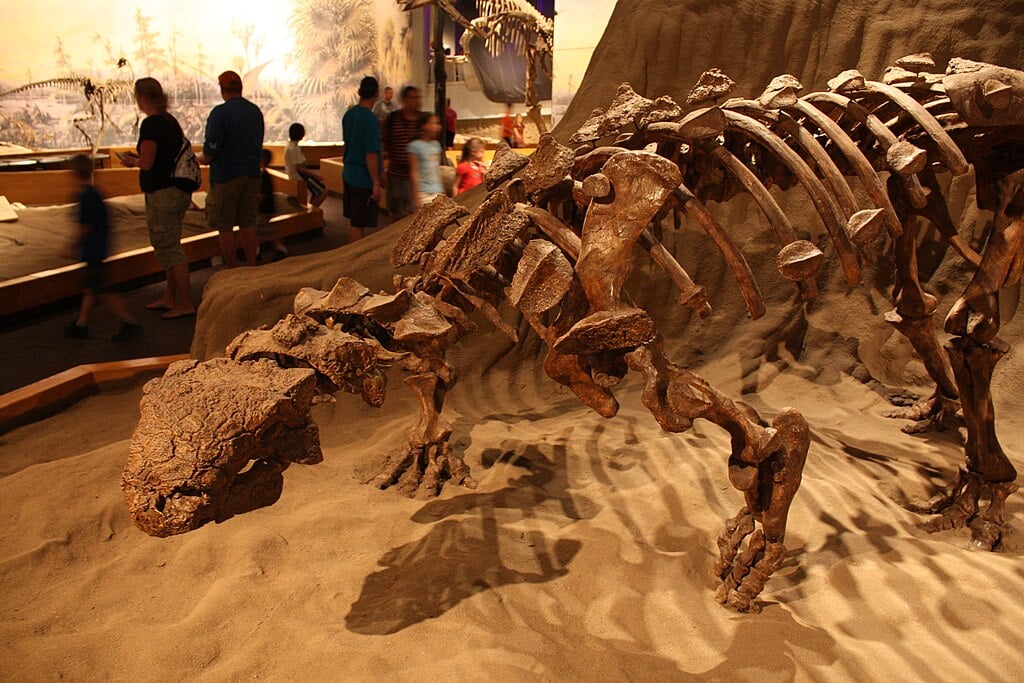

A team of paleontologists has uncovered the first known fossil footprints belonging to armored dinosaurs with tail clubs. This discovery reveals new evidence about a little-understood group of ancient creatures that once roamed western Canada.
The 100-million-year-old tracks were discovered at two separate sites: one near Tumbler Ridge, British Columbia, and another in northwestern Alberta.
The findings, now published in the Journal of Vertebrate Paleontology, offer critical insight into a period where skeletal fossils from this specific group are nearly absent in North America.
The dinosaurs behind the footprints are believed to belong to the ankylosaurid family. These armored, plant-eating creatures are recognizable by their thick body armor and heavy tail clubs.
While previous track discoveries have been linked to nodosaurids, a related group with flexible tails and four toes, these new prints show only three toes, a key trait of ankylosaurids.
La’momia’de un dinosaurio nodosaurio se revela con la piel y las tripas intactas.El fósil de un nodosaurio,de 110 millones de años de antigüedad,fue hallado por accidente por mineros canadienses en 2011..Es el fosil mejor conservado del mundo.Museo Royal Tyrrell Alberta,Canadá. pic.twitter.com/ZSAnOFCmok
— Curiotweet (@Curiotweet1) August 11, 2020
The tracks notably differ from the well-known four-toed Tetrapodosaurus borealis prints found throughout North America.
Based on these distinct features, the team identified the new ichnospecies as Ruopodosaurus clava, “the tumbled-down lizard with a club.” It references the mountainous region where the footprints were found and the dinosaur’s likely defensive tail weapon.
Dr. Victoria Arbour, curator of paleontology at the Royal BC Museum said, “While we don’t know exactly what the dinosaur that made Ruopodosaurus footprints looked like, we know that it would have been about 5-6 meters long, spiky and armored, and with a stiff tail or a full tail club.”
“Ankylosaurs are my favorite group of dinosaurs to work on,” she added. “So being able to identify new examples of these dinosaurs in British Columbia is really exciting for me.”
The discovery is the result of years of observation by Dr. Charles Helm, a scientific advisor at the Tumbler Ridge Museum. Helm had noted several unusual three-toed trackways in the area and invited Arbour to help examine them during a visit in 2023.
For the first time, 100-million-year-old fossilized footprints of tail-clubbed ankylosaurid dinosaurs, named Ruopodosaurus clava, have been discovered in the Canadian Rockies at Tumbler Ridge, BC, and northwestern Alberta.
Unlike four-toed nodosaurid tracks, these three-toed… pic.twitter.com/otazzRmiYM
— Nirmata (@En_formare) April 14, 2025
“Ever since two young boys discovered an ankylosaur trackway close to Tumbler Ridge in the year 2000, ankylosaurs and Tumbler Ridge have been synonymous,” said Helm.
“It is really exciting to now know through this research that there are two types of ankylosaurs that called this region home and that Ruopodosaurus has only been identified in this part of Canada.”
The study team also included Eamon Drysdale, curator at the Tumbler Ridge Museum; Roy Rule, geoscientist at the Tumbler Ridge UNESCO Global Geopark; and the late Dr. Martin Lockley of the University of Colorado.
The tracks date back to the mid-Cretaceous period, between 100 and 94 million years ago. For decades, the absence of ankylosaurid skeletons from that era led some scientists to question whether the animals had temporarily vanished from North America.
These newly identified tracks confirm they were still present and even shared the environment with nodosaurids.
“This study also highlights how important the Peace Region of northeastern BC is for understanding the evolution of dinosaurs in North America—there’s still lots more to be discovered,” said Arbour.
The footprints offer a rare glimpse into a missing chapter of dinosaur history, adding to what scientists know about the diversity and survival of armored dinosaurs on ancient Canadian landscapes.
